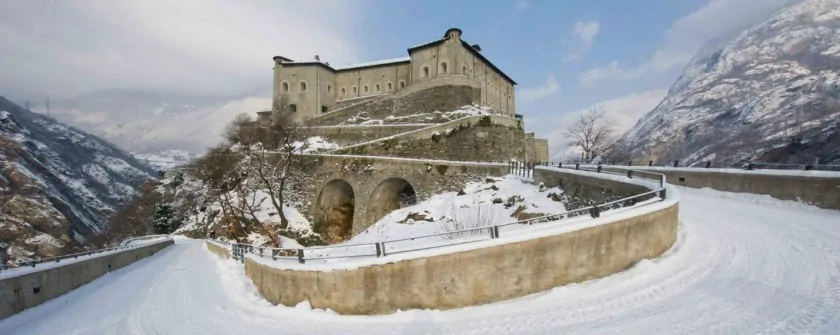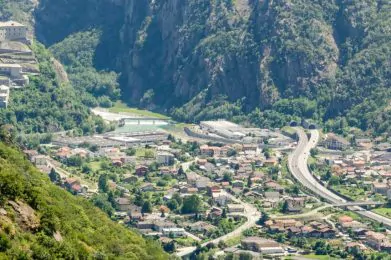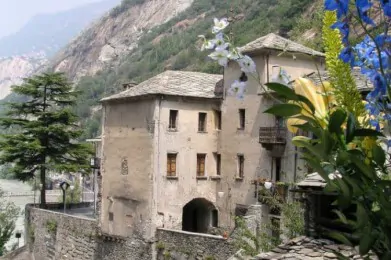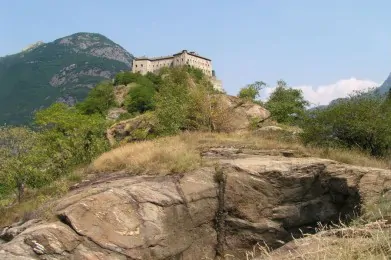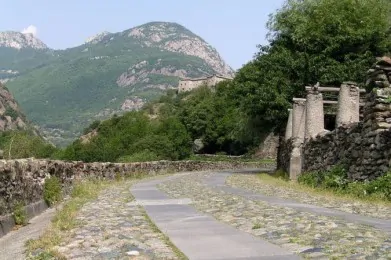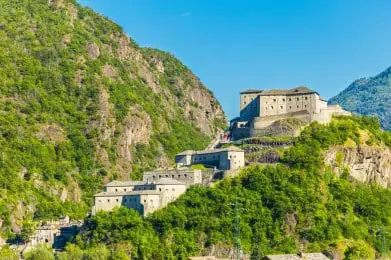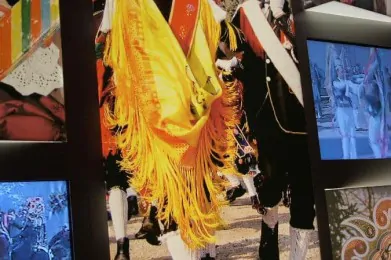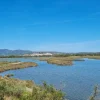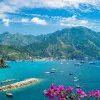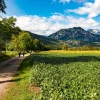It is the unmistakable shape of the Serra Morenica that characterizes the part of Canavese lands that take us from the northern suburbs of Turin to Valle d’Aosta. An alternation of cultivated plains, hills, villages and castles accompanies us to the foot of the mountains.
Settimo Vittone and Carema are the last Piedmontese centers we meet before arriving in the Alpine region. The village of Pont-Saint-Martin, which welcomes us in the valley, is the gateway to the region and the valley of Lys, one of the valleys of Monte Rosa.
A handful of kilometers, overlooking the vineyards of Donnas and here we are in Bard, the imposing fortress perched on a spur of rock from the slopes bathed by the waters of the Dora Baltea.

A magnificent example of military architecture, the fort, which maintains the original features of some structures, offers the interesting Museum of the Alps, whose exhibition itinerary is spread over thirty rooms. The museum recounts through sounds, videos and three-dimensional reconstructions, a mountain lived and transformed by the hand of man.
Divided into four sections, including one dedicated to alpine nature, one to the genesis of the Alps, to alpine civilization from the Bronze Age to the late nineteenth century, and to the period that begins with the romantic discovery of the Alps to mass tourism.
Not to be missed in the complex of the fort also the interesting Museum of the Fortifications, that of the Frontiers and the historical Prisons. Delightful the village nestled on the slopes of the rocky spur dominated by the fort.
Its monumental houses are beautiful, including Casa Valperga, Casa Challant, Casa Ciucca, the elegant Palazzo dei nobili Nicole, Casa della Meridiana and the Casa del Vescovo. Gourmet stop in one of its restaurants where we allow ourselves a good plate of polenta and a taste of genepy, a typical local liqueur obtained with the maceration of alpine artemisie in alcohol.
We leave Bard, along the Dora, to continue towards the upper valley. The castle of Issogne, that of Verres and that of Ussel accompany us towards Aosta, the regional capital located in a large basin in the heart of the region. We continue to the valley of the Great St. Bernard.
The valley is dominated by the shape of the Gran Combin, one of the four thousand in this corner of the Alps. It is the village of Etroubles the heart of the valley.

Its medieval center is an open-air museum, an authentic permanent art gallery. The painter and sculptor Salvatore Sebaste, the painter Carlo Brenna, then the French sculptor Albert Feraud and the Swiss artist Hans Erni, just to name a few, are the many artists who have enriched with their works the village, its most characteristic corners. For years, during the summer, Etroubles is also home to numerous level exhibitions, with major artists of the last centuries such as Picasso, Chagall, Degas, Diego and Alberto Giacometti, Favre and many others. The history of the village tells of people walking towards Rome, coming from northern Europe, who passed through the heart of Etroubles along the Via Francigena, on foot, sometimes on horseback or even on the back of a mule. They crossed what is still today one of the most beautiful villages in the Alps, which in 1800 was crossed by the Napoleonic army, among cobbled streets, the characteristic fountains, the houses with stone roofs, dominated by the imposing fifteenth-century Romanesque bell tower, where The parish church of 1815 also deserves a visit.
You can not leave the Gran San Bernardo valley without having enjoyed a good plate of Valpellina soup. Ancient recipe prepared with bread, fontina cheese, meat broth, butter and savoy cabbage. A hearty dish that we accompany with an Arnad Montjovet, a dry red wine typical of the areas of Arnad, Verrès, Issogne, Montjovet and Challand-Saint-Victor. Final dessert with some Tegola, crispy waffles, typical regional biscuits.
On the way back to Turin, the Dora valley continues to enchant us with mounts, villages and castles. The fort of Bard accompanies us in the last stretch before landing again in the Canavese, dominating the valley floor. Then the plain takes us up to the outskirts of Turin and to the unmistakable silhouette of the Mole Antonelliana.

